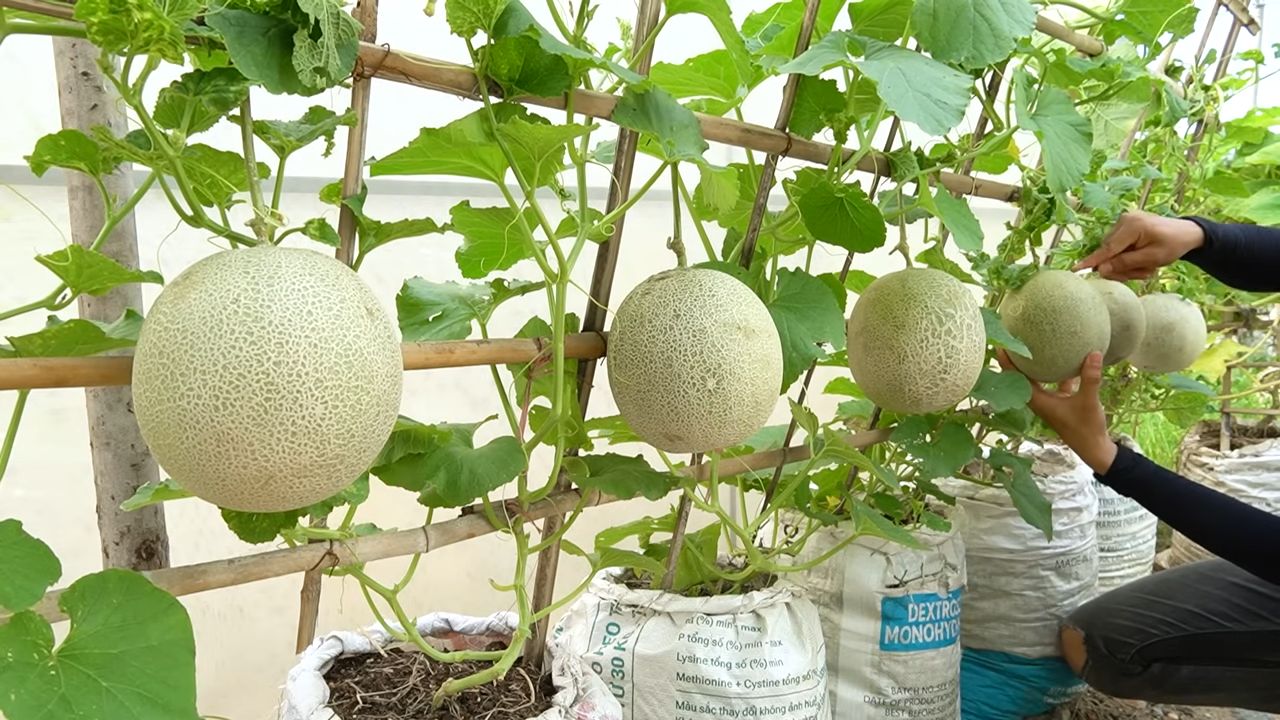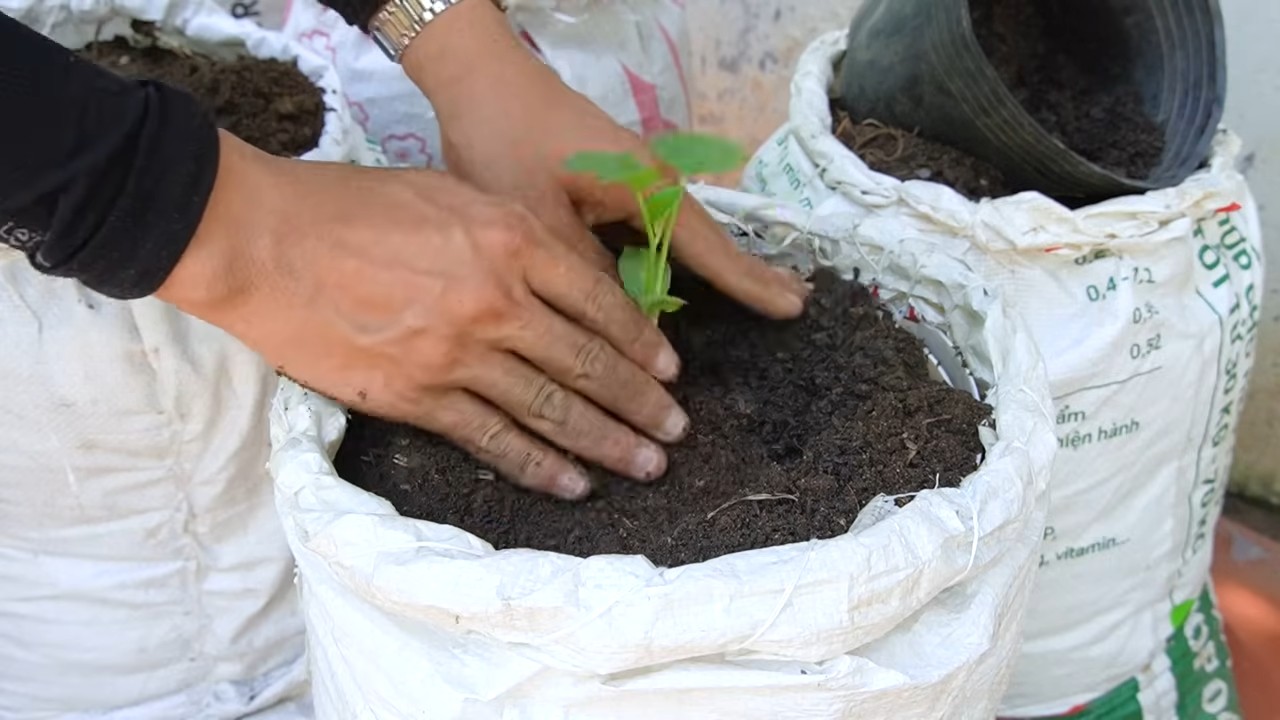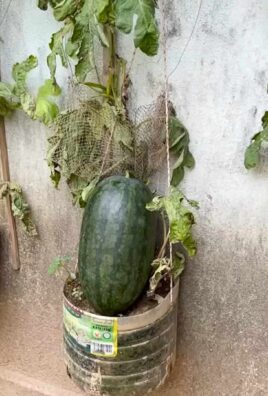Grow Cantaloupe in Grow Bags? Absolutely! Imagine biting into a juicy, sun-ripened cantaloupe that you nurtured from seed to fruit, right on your patio or balcony. Sounds dreamy, doesn’t it? For centuries, gardeners have cherished cantaloupe for its sweet flavor and refreshing qualities. From ancient Egypt, where it was a prized delicacy, to modern-day backyard gardens, this melon has always held a special place in our hearts (and stomachs!).
But let’s face it, not everyone has the space for a sprawling cantaloupe vine. That’s where this DIY guide comes in! I’m going to show you how to successfully grow cantaloupe in grow bags, even if you’re short on space or new to gardening. This trick is a game-changer because it allows you to control the soil quality, manage watering more effectively, and even move your plants to chase the sun. Plus, it’s incredibly rewarding to harvest your own delicious cantaloupe. So, ditch the store-bought melons and get ready to enjoy the sweet taste of homegrown goodness! Let’s get started!

Grow Cantaloupe in Grow Bags: A Sweet Summer Project!
Hey there, fellow gardening enthusiasts! I’m so excited to share my experience growing cantaloupe in grow bags. It’s a fantastic way to enjoy this delicious fruit, even if you don’t have a sprawling garden. Grow bags are perfect for small spaces, patios, or balconies. Trust me, the taste of a homegrown cantaloupe is worth the effort!
Why Grow Cantaloupe in Grow Bags?
Before we dive in, let’s talk about why grow bags are a great option for cantaloupe:
* Space-Saving: Grow bags take up minimal space compared to traditional garden beds.
* Portability: You can easily move your cantaloupe plants to follow the sun or protect them from harsh weather.
* Improved Drainage: Grow bags provide excellent drainage, preventing root rot, which cantaloupe are susceptible to.
* Warmer Soil: The fabric of grow bags warms up quickly, promoting faster growth, especially in cooler climates.
* Air Pruning: The fabric allows air to reach the roots, encouraging them to branch out and create a stronger root system.
Choosing the Right Grow Bag and Variety
Okay, let’s get started! The first step is selecting the right grow bag and cantaloupe variety.
* Grow Bag Size: I recommend using a grow bag that’s at least 15-20 gallons in size. Cantaloupe plants need plenty of room for their roots to develop. A larger bag is always better than a smaller one.
* Grow Bag Material: Fabric grow bags are the way to go. They’re breathable and allow for air pruning. Avoid plastic pots, as they can overheat and retain too much moisture.
* Cantaloupe Variety: Choose a variety that’s well-suited to your climate and growing season. Smaller varieties like ‘Sugar Cube’ or ‘Minnesota Midget’ are excellent choices for grow bags, as they tend to be more compact and produce smaller fruits. Larger varieties can also be grown, but you might need to provide extra support for the vines and fruits.
Materials You’ll Need
Here’s a list of everything you’ll need for this project:
* Grow bag (15-20 gallons)
* Cantaloupe seeds or seedlings
* High-quality potting mix (well-draining)
* Compost or aged manure
* Slow-release fertilizer (specifically for fruits and vegetables)
* Watering can or hose
* Trellis or support structure (optional, but recommended)
* Gardening gloves
* Pruning shears or scissors
* Mulch (optional)
Step-by-Step Instructions: Planting Your Cantaloupe
Now for the fun part! Let’s get those cantaloupe seeds or seedlings into the grow bag.
1. Prepare the Grow Bag: Place the grow bag in a sunny location that receives at least 6-8 hours of direct sunlight per day. Cantaloupe plants are sun-worshippers!
2. Mix the Soil: In a large container or wheelbarrow, combine the potting mix with compost or aged manure. I usually go for a ratio of about 2 parts potting mix to 1 part compost. This will provide your cantaloupe plants with essential nutrients. Add the slow-release fertilizer according to the package instructions. Mix everything thoroughly.
3. Fill the Grow Bag: Fill the grow bag with the soil mixture, leaving about 2-3 inches of space at the top. This will make watering easier and prevent soil from spilling over.
4. Plant the Seeds or Seedlings:
* From Seed: Sow 2-3 cantaloupe seeds about 1 inch deep in the center of the grow bag. Water gently to moisten the soil. Keep the soil consistently moist until the seeds germinate, which usually takes about 7-10 days. Once the seedlings emerge, thin them to one strong plant.
* From Seedling: Gently remove the cantaloupe seedling from its container. Loosen the roots slightly and plant it in the center of the grow bag, at the same depth it was growing in its original container. Water thoroughly.
5. Mulch (Optional): Add a layer of mulch around the base of the plant to help retain moisture, suppress weeds, and regulate soil temperature. Straw, wood chips, or shredded bark are all good options.
6. Watering: Water your cantaloupe plant regularly, especially during hot, dry weather. Aim to keep the soil consistently moist, but not waterlogged. Water deeply, allowing the water to soak into the soil. Avoid wetting the foliage, as this can encourage fungal diseases. I usually water in the morning to give the foliage time to dry before nightfall.
Caring for Your Cantaloupe Plants
Once your cantaloupe plants are established, it’s important to provide them with proper care to ensure a bountiful harvest.
1. Fertilizing: Cantaloupe plants are heavy feeders, so regular fertilization is essential. In addition to the slow-release fertilizer you added at planting time, you can supplement with a liquid fertilizer every 2-3 weeks. Choose a fertilizer that’s high in phosphorus and potassium, which are important for fruit development. Follow the package instructions carefully.
2. Trellising: Cantaloupe vines can get quite long and heavy, so providing a trellis or support structure is highly recommended. This will help keep the fruits off the ground, preventing rot and making them easier to harvest. You can use a simple tomato cage, a sturdy trellis, or even a fence. Train the vines to grow up the support structure by gently tying them with soft twine or plant ties.
3. Pruning: Pruning can help improve air circulation and encourage fruit production. Remove any yellowing or dead leaves. You can also prune the lateral vines (the ones that grow out from the main vine) to encourage the plant to focus its energy on producing fruits. However, be careful not to prune too heavily, as the leaves are needed for photosynthesis.
4. Pollination: Cantaloupe plants require pollination to produce fruits. Bees are the primary pollinators, so encourage them to visit your garden by planting flowers that attract them. If you’re not seeing many bees, you may need to hand-pollinate the flowers. To do this, use a small paintbrush to transfer pollen from the male flowers (which have a long, thin stem) to the female flowers (which have a small fruit at the base).
5. Pest and Disease Control: Keep an eye out for common cantaloupe pests, such as aphids, squash bugs, and cucumber beetles. You can control these pests with insecticidal soap or neem oil. Cantaloupe plants are also susceptible to fungal diseases, such as powdery mildew and downy mildew. To prevent these diseases, provide good air circulation, avoid wetting the foliage, and apply a fungicide if necessary.
Harvesting Your Cantaloupe
The moment you’ve been waiting for! Harvesting your homegrown cantaloupe is the most rewarding part of the process.
1. Signs of Ripeness: Cantaloupe are typically ready to harvest about 75-90 days after planting. Here are some signs that your cantaloupe is ripe:
* Color Change: The skin of the cantaloupe will change from green to a tan or yellowish color.
* Aroma: The cantaloupe will have a sweet, musky aroma.
* Stem Separation: The stem will begin to separate from the fruit, forming a crack around the stem. This is called “slipping.”
* Sound: When you tap the cantaloupe, it will sound hollow.
2. Harvesting: To harvest your cantaloupe, gently lift the fruit and twist it until the stem separates from the vine. If the stem doesn’t separate easily, it’s not quite ripe yet. Leave it on the vine for a few more days and check again.
3. Enjoy! Once you’ve harvested your cantaloupe, wash it thoroughly and enjoy! You can eat it fresh, add it to salads, or use it in smoothies. Store any leftover cantaloupe in the refrigerator.
Troubleshooting Tips
Here are a few common problems you might encounter when growing cantaloupe in grow bags, and how to solve them:
* Poor Fruit Set: If your cantaloupe plants are producing flowers but not setting fruit, it could be due to poor pollination. Try hand-pollinating the flowers or attracting more bees to your garden.
* Yellowing Leaves: Yellowing leaves can be a sign of nutrient deficiency. Fertilize your plants with a balanced fertilizer or a fertilizer specifically formulated for fruits and vegetables.
* Root Rot: Root rot is caused by overwatering and poor drainage. Make sure your grow bag has good drainage and avoid overwatering.
* Pest Infestations: Regularly inspect your plants for pests and take action promptly if you find any. Insecticidal soap or neem oil

Conclusion
So, there you have it! Growing cantaloupe in grow bags isn’t just a trend; it’s a game-changer for gardeners of all levels, especially those with limited space or less-than-ideal soil conditions. We’ve walked through the entire process, from selecting the right grow bag and choosing the perfect cantaloupe variety to nurturing your plants and harvesting those sweet, juicy melons.
But why is this DIY trick a must-try? Let’s recap the compelling reasons:
* Space Efficiency: Grow bags allow you to cultivate cantaloupe even on balconies, patios, or small yards. No need for a sprawling garden!
* Improved Drainage and Aeration: The fabric construction of grow bags promotes excellent drainage and aeration, preventing root rot and fostering healthy root development. This is crucial for cantaloupe, which are susceptible to overwatering.
* Portability: Need to move your plants to chase the sun or protect them from unexpected frost? Grow bags make it easy.
* Soil Control: You have complete control over the soil composition, ensuring your cantaloupe receives the nutrients it needs to thrive.
* Warmer Soil Temperatures: Grow bags tend to warm up faster than in-ground soil, giving your cantaloupe a head start in the growing season.
Ready to take your cantaloupe growing to the next level? Consider these variations and suggestions:
* Vertical Growing: Train your cantaloupe vines up a trellis or support structure near your grow bag to maximize space and improve air circulation. This is especially helpful for larger varieties.
* Companion Planting: Plant basil, marigolds, or nasturtiums near your cantaloupe to deter pests and attract beneficial insects.
* Succession Planting: Plant cantaloupe seeds in stages, a few weeks apart, to extend your harvest season.
* Experiment with Varieties: Don’t be afraid to try different cantaloupe varieties to find your favorites. Some popular choices for grow bags include ‘Sugar Cube,’ ‘Minnesota Midget,’ and ‘Charentais.’
* Watering System: Consider using a drip irrigation system or self-watering grow bag to ensure consistent moisture levels, especially during hot weather.
Growing cantaloupe in grow bags is a rewarding and accessible way to enjoy fresh, homegrown melons. It’s a project that combines the satisfaction of DIY with the deliciousness of a bountiful harvest. So, grab your grow bags, select your seeds, and get ready to embark on a cantaloupe-growing adventure!
We’re confident that you’ll be amazed by the results. Don’t forget to share your experiences with us! Post photos of your cantaloupe plants and harvests on social media using [Your Hashtag Here] and let us know what worked best for you. We’re eager to learn from your successes and help you troubleshoot any challenges you encounter. Happy gardening!
Frequently Asked Questions (FAQ)
What size grow bag is best for growing cantaloupe?
The ideal grow bag size for cantaloupe is typically between 10 and 20 gallons. A 15-gallon grow bag is a good starting point, providing ample space for the roots to develop and support the plant’s growth. Smaller varieties might do well in 10-gallon bags, while larger varieties may benefit from a 20-gallon bag. Consider the mature size of the cantaloupe variety you choose when selecting your grow bag. Remember, adequate space is crucial for healthy root development and fruit production.
What type of soil should I use in my cantaloupe grow bag?
Cantaloupe thrives in well-draining, nutrient-rich soil. A good mix consists of equal parts of the following:
* Compost: Provides essential nutrients and improves soil structure.
* Potting Mix: Offers good drainage and aeration.
* Topsoil: Adds bulk and helps retain moisture.
You can also amend the soil with slow-release fertilizer or bone meal to provide a steady supply of nutrients throughout the growing season. Avoid using heavy clay soil, as it can retain too much moisture and lead to root rot. Ensure the soil pH is between 6.0 and 6.8 for optimal cantaloupe growth.
How often should I water my cantaloupe plants in grow bags?
Watering frequency depends on several factors, including the weather, the size of the grow bag, and the stage of plant growth. Generally, you should water your cantaloupe plants deeply whenever the top inch of soil feels dry to the touch. During hot, dry weather, you may need to water daily. Avoid overwatering, as this can lead to root rot. Grow bags tend to dry out faster than in-ground soil, so check the moisture levels regularly. A good rule of thumb is to water until you see water draining from the bottom of the bag.
How much sunlight do cantaloupe plants need in grow bags?
Cantaloupe plants require at least 6-8 hours of direct sunlight per day to produce sweet, flavorful melons. Choose a location for your grow bags that receives ample sunlight throughout the day. If you live in a particularly hot climate, you may need to provide some afternoon shade to prevent the plants from overheating. Monitor your plants closely and adjust their location as needed to ensure they receive the optimal amount of sunlight.
Do I need to fertilize my cantaloupe plants in grow bags?
Yes, cantaloupe plants are heavy feeders and benefit from regular fertilization. Start by incorporating slow-release fertilizer into the soil mix when you plant your seedlings. Then, supplement with liquid fertilizer every 2-3 weeks throughout the growing season. Use a balanced fertilizer with a higher phosphorus content to promote fruit development. Avoid over-fertilizing, as this can lead to excessive foliage growth and reduced fruit production. Follow the instructions on the fertilizer label carefully.
How do I prevent pests and diseases from affecting my cantaloupe plants in grow bags?
Several pests and diseases can affect cantaloupe plants, including aphids, squash bugs, powdery mildew, and fusarium wilt. To prevent these problems, follow these tips:
* Choose disease-resistant varieties: Select cantaloupe varieties that are known to be resistant to common diseases.
* Practice good sanitation: Remove any dead or diseased leaves and debris from around the plants.
* Water properly: Avoid overwatering and water at the base of the plants to prevent fungal diseases.
* Use insecticidal soap or neem oil: Treat infestations of aphids, squash bugs, or other pests with insecticidal soap or neem oil.
* Provide good air circulation: Space your plants adequately to allow for good air circulation.
* Rotate crops: Avoid planting cantaloupe in the same location year after year.
How do I know when my cantaloupe is ripe and ready to harvest from the grow bag?
Determining when a cantaloupe is ripe can be tricky, but here are a few signs to look for:
* Color change: The skin of the cantaloupe will change from green to a tan or yellowish color.
* Aroma: A ripe cantaloupe will have a sweet, musky aroma.
* Stem slip: The stem will begin to separate easily from the fruit. This is known as “slipping.”
* Sound: When you tap on the cantaloupe, it should sound hollow.
Once the cantaloupe exhibits these signs, it’s likely ripe and ready to harvest. Gently twist the fruit from the vine, or use pruning shears to cut the stem close to the fruit. Enjoy your homegrown cantaloupe!




Leave a Comment